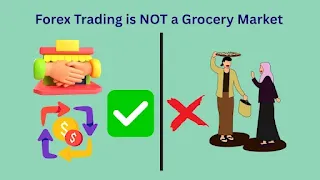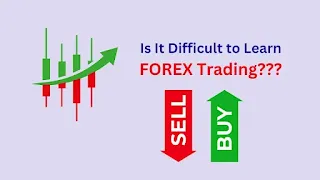You might be wondering, what exactly is Forex trading? And what's this "spread" everyone talks about? Well, stay steady, because today we're going to demystify one of the most fundamental concepts in currency trading – the "Spread."
Imagine you're at a bustling marketplace. Not just any market, but a global market where currencies from all over the world are bought and sold. This, in essence, is Forex – the Foreign Exchange market. It's the largest financial market in the world, far bigger than the stock market. We're talking trillions of dollars changing hands every single day!
Now, just like any market, there are buyers and sellers. When you go to a shop to buy a chocolate bar, the shopkeeper has a price at which they sell it to you. And if you wanted to sell something back to them, they might offer you a slightly lower price. That little difference is what we're going to explore today in the world of Forex.
What is "Spread" in Forex Trading? The Simple Truth
Let's break down "Spread". Think of it like a small fee or a commission that you pay when you exchange currencies. It's the difference between the price at which you can buy a currency pair and the price at which you can sell it.
In Forex, currencies are always traded in pairs. For example, EUR/USD. This means we are looking at the Euro (EUR) against the US Dollar (USD). When you see a price quote for EUR/USD, you'll usually see two numbers. Let's say:
EUR/USD: 1.0850 / 1.0852
The first number, 1.0850, is the Bid Price. This is the price at which your broker (the company that helps you trade) is willing to buy the base currency (EUR) from you. In simple terms, it's the price you can sell at.
The second number, 1.0852, is the Ask Price (also sometimes called the Offer Price). This is the price at which your broker is willing to sell the base currency (EUR) to you. This is the price you can buy at.
Do you see the tiny difference between 1.0850 and 1.0852? Yes, it's just 0.0002. This tiny difference, my friends, is the Spread.
Why Does the Spread Exist?
Good question! The spread exists for a few important reasons:
Broker's Profit: This is the primary reason. Your Forex broker is a business, and they need to make money to provide you with their services (like giving you access to the market, advanced trading platforms, and customer support). The spread is their way of earning a profit on each trade you make. It's like the shopkeeper's profit margin on that chocolate bar.
Liquidity: Think of liquidity as how easily you can buy or sell something without changing its price much. Highly liquid markets (like the Forex market for major currency pairs) usually have smaller spreads because there are always lots of buyers and sellers. Less liquid markets might have wider spreads.
Market Volatility: When the market is very active and prices are jumping around a lot (high volatility), brokers might widen the spread to protect themselves from rapid price changes. During calm periods, spreads tend to be tighter.
How Do We Measure the Spread?
We measure the spread in "pips." A pip (Percentage in Point) is the smallest unit of price movement in a currency pair. For most currency pairs, a pip is the fourth decimal place.
Going back to our example:
EUR/USD: 1.0850 / 1.0852
Spread = Ask Price - Bid Price
Spread = 1.0852 - 1.0850 = 0.0002
Since one pip is 0.0001, a spread of 0.0002 means the spread is 2 pips.
Let's look at another example:
USD/JPY: 145.25 / 145.28
Here, the pip is usually the second decimal place.
Spread = 145.28 - 145.25 = 0.03
So, the spread here is 3 pips.
Different Types of Spreads
Not all spreads are created equal! There are two main types you'll encounter:
Fixed Spreads: As the name suggests, these spreads generally remain constant, no matter what's happening in the market. They don't change much with market volatility. This can be good for beginners as it offers predictability. However, fixed spreads might sometimes be slightly wider than variable spreads.
Variable Spreads (or Floating Spreads): These spreads change based on market conditions. During calm periods with high liquidity, variable spreads can be very tight, even as low as 0.5 pips for major pairs. But during news events or periods of high volatility, they can widen significantly. Most ECN (Electronic Communication Network) brokers offer variable spreads.
Here's a quick comparison:
Why is Understanding Spread Important for You?
Understanding the spread is absolutely crucial for a Forex trader. Here's why:
Cost of Trading: The spread is essentially a transaction cost. Every time you open a trade, you immediately start with a small "loss" equal to the spread. This is because you buy at the higher Ask price, and if you were to immediately sell, you'd sell at the lower Bid price.
Profitability: For short-term traders (like scalpers who open and close trades very quickly to make small profits), a wide spread can eat into their profits very quickly. Even for long-term traders, consistently high spreads can reduce overall profitability.
Choosing a Broker: When you're looking for a Forex broker, the spreads they offer are a huge factor. A broker with consistently tight spreads on the currency pairs you trade can save you a lot of money in the long run.
Risk Management: Knowing about spreads helps you plan your trades better. If you anticipate a major news announcement that might widen spreads, you might choose to avoid trading during that time or adjust your stop-loss levels accordingly.
My Personal Experience with Spreads
When I started my journey 15 years ago, from the small city of Patna, I remember being fascinated by how these seemingly tiny numbers could make such a big difference. I learned the hard way that ignoring spreads is like ignoring the petrol cost when planning a long drive – you won't get far!
I've seen spreads on EUR/USD as low as 0.5 pips during quiet trading hours and as high as 10-15 pips during major economic announcements like interest rate decisions. These extreme widenings can wipe out small accounts if not managed properly.
This is why, in my "Forex Trading with Mukesh" course, we dedicate significant time to understanding not just the mechanics of spreads but also how to choose brokers with favourable spreads, how to factor spreads into your trading strategy, and how to navigate periods of high volatility when spreads tend to widen.
Ready to Dive Deeper into Forex?
The world of Forex trading is truly captivating. It's a skill that can empower you, offering financial freedom and a deep understanding of global economics. If the idea of trading currencies, analysing charts, and making informed decisions excites you, then you're in the right place.
I teach Forex trading to students from basic to advanced levels, making sure even the most complex concepts are broken down into easily digestible parts, just like we did with "spread" today. My course, "Forex Trading with Mukesh," is designed to take you from a complete beginner to a confident trader.
And here's a little something extra: I have a Telegram channel where anyone interested in learning Forex can join. Every single day, I share my Forex chart analysis and provide free signals. It's a fantastic way to see live trading examples and learn from real-time market movements.
Plus, when you enrol in the course, you'll receive a copy of my comprehensive Forex Trading ebook, written by me, absolutely free! It's packed with strategies, tips, and insights gained from my 15 years of experience.
So, are you ready to embark on this journey with me? Understanding spreads is just the beginning. There's a whole world of charts, patterns, strategies, and opportunities waiting for you. Let's make sense of the markets together!
Join my Telegram channel today (you can find the link by searching "Forex Trading with Mukesh" on Telegram, or reach out to me directly. Let's start building your trading knowledge. I look forward to welcoming you to the family!
Suggested articles for you:








